Salmon Fish Cakes
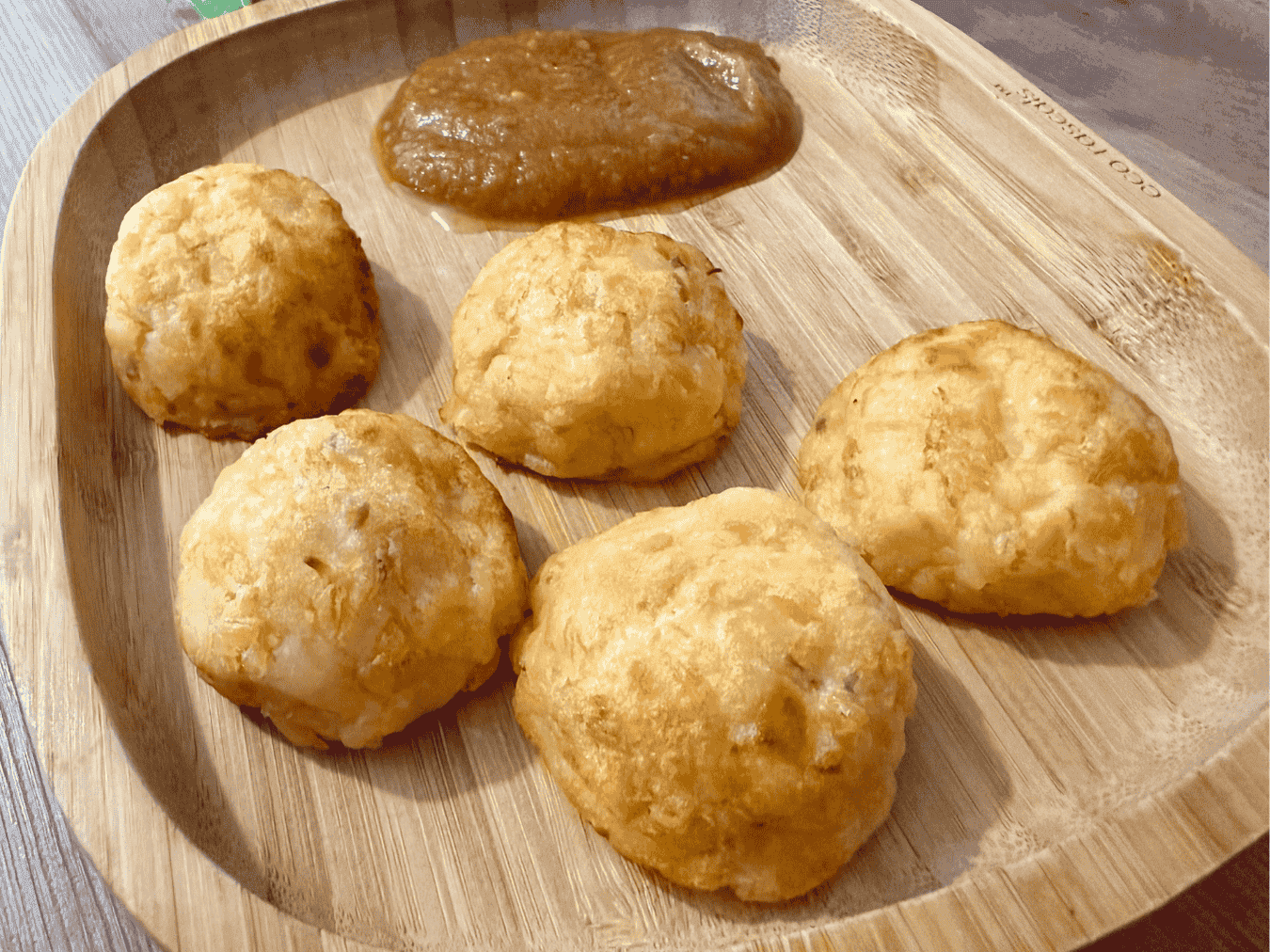
Written by Kenny Ekerin
Fact Checked by Mindsmaking Professionals
14th, July, 2025
This post may contain affiliate links. Please read our disclosure policy.
These homemade salmon fish cakes are perfect for babies, toddlers, and the whole family. Soft, flavorful, and packed with omega-3s and protein, they're easy to make, customizable with veggies, and great for baby-led weaning or a quick family dinner.

Reasons to Love Salmon Fish Cakes
Nutrient-Rich: Packed with protein, omega-3 fatty acids, vitamins (A, D, B12), and minerals (calcium, potassium).
Kid-Friendly: Soft, easy-to-eat, and perfect for toddlers and babies.
Versatile: Customisable with vegetables, herbs, and seasonings to suit all tastes.
Quick and Easy: Simple to prepare and cook, making it a great option for busy families.
Healthy: A lighter, baked alternative to fried fish cakes, lower in unhealthy fats.
Freezer-Friendly: Can be made ahead and stored for quick meals later.
Satisfying: Filling and balanced, great for any meal—lunch, dinner, or a snack!
Salmon Fish Cakes Recipe
Ingredients
- 200g salmon fillet (skinless and boneless)
- 2 medium potatoes (peeled and diced into chunks)
- ½ cup (50g) grated cheese (mild cheddar works well)
- 1 tsp garlic powder (optional, for flavour enhancement)
- Optional: A pinch of black pepper
Mindsmaking
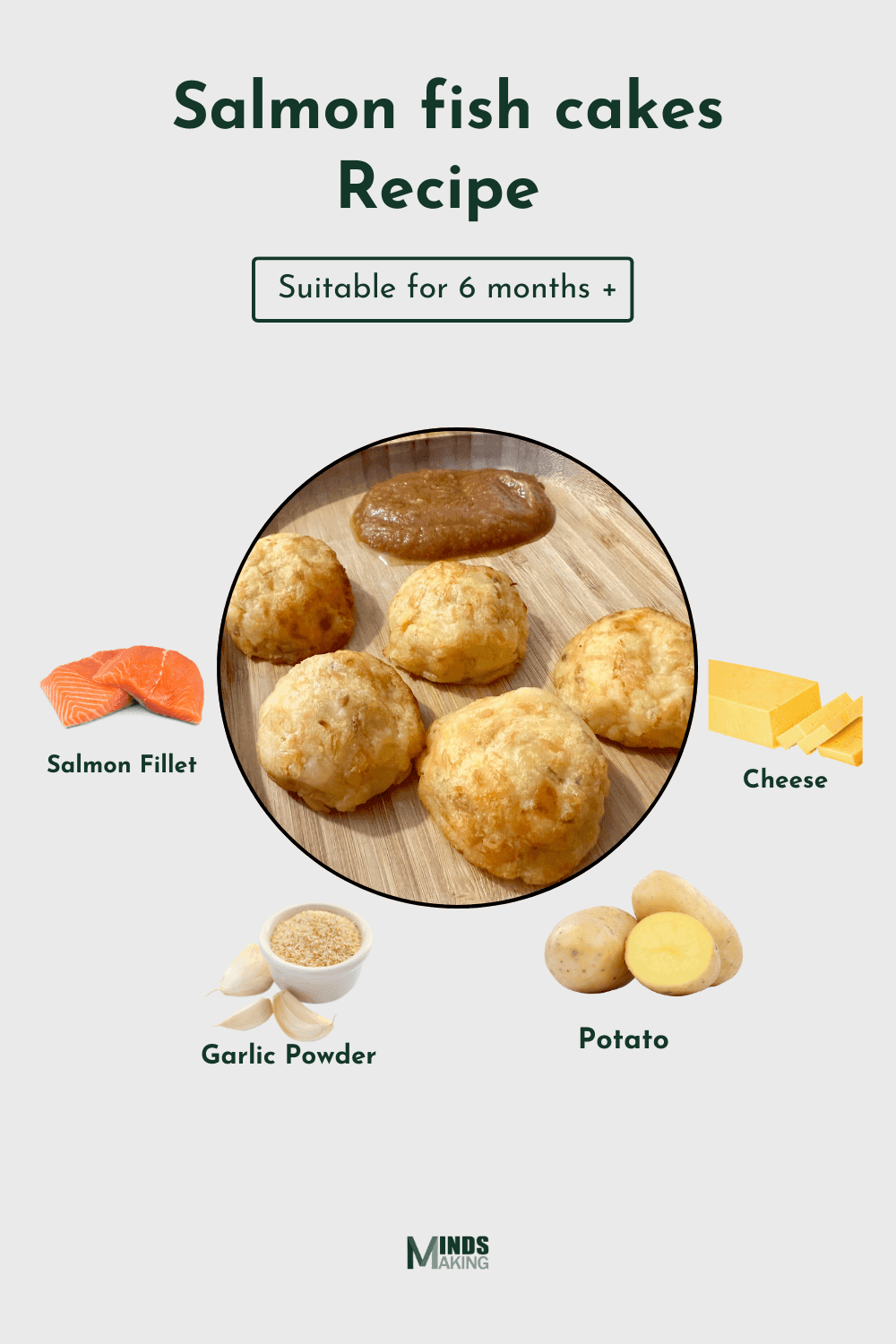
Instructions
1. Prepare the Ingredients: Peel and dice the potatoes into small chunks for even cooking. Pat the salmon fillet dry if using fresh salmon.
2. Cook the Salmon and Potatoes: Place the potato chunks and salmon fillet in a steamer basket over boiling water. Cover and steam for 12–15 minutes, or until the potatoes are tender and the salmon is cooked through (opaque and flaky).
Mindsmaking

3. Boiling Method: Place the potatoes in a saucepan of water and boil for 10–12 minutes. During the last 5 minutes of boiling, add the salmon fillet to the potatoes. Once done, remove both salmon and potatoes and let them cool slightly. If boiled, pat them dry with a clean kitchen towel to avoid excess moisture.
4. Mash and Mix: Transfer the cooked salmon and potatoes to a mixing bowl. Use a fork to mash them together until they are well combined and smooth. Add ½ cups of grated cheese and 1 tsp of garlic powder (if using). Mix thoroughly.
5. Shape the Fish Cakes: Take small portions of the mixture (about 2 tablespoons each) and shape them into balls.
Mindsmaking
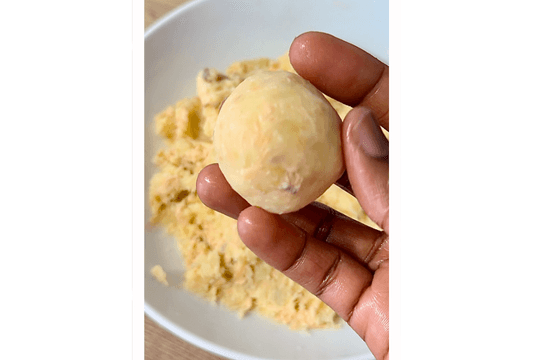
6. Bake the Fish Cakes: Preheat your oven to 175°C (350°F). Line a baking sheet with parchment paper or lightly grease it. Arrange the fish cakes on the baking sheet, leaving some space between them. Bake in the preheated oven for 18–20 minutes, or until the fish cakes are lightly golden on the outside.
Mindsmaking
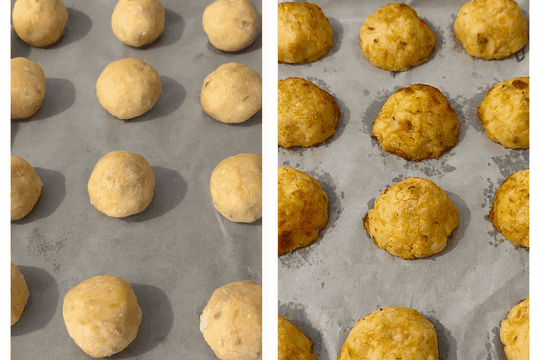
7. Cool and Serve: Allow the fish cakes to cool slightly before serving, especially if serving to babies or toddlers. These fish cakes are soft and easy for little ones to eat, making them perfect for baby-led weaning, toddlers, and family meals.
Mindsmaking
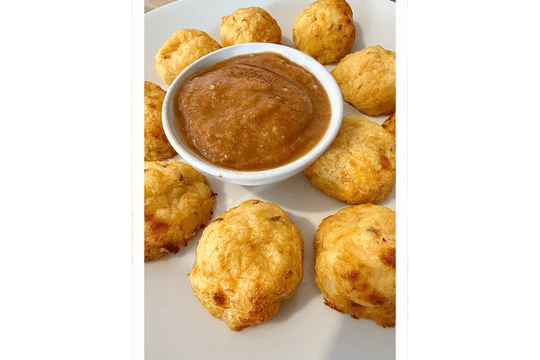
Read This Next

Recipe Ebook
Essential Guide to Starting Solids for Babies 6 Months+ - LBH Top 70 Baby Puree & Porridge Recipes eBook.
Start your baby’s solids journey with confidence using this "70 Baby Purees & Porridges" eBook! Created with care, this digital guide is packed with nutrient-rich recipes for babies 6 months and older, including purees and porridges tailored to each stage of your baby’s development.
Tips for Success
Choose the Right Salmon: Use fresh or frozen salmon fillets without skin or bones. If using frozen salmon, make sure to thaw it completely and pat it dry before cooking to avoid excess moisture. You can also use canned salmon (drained well and flaked) as a convenient alternative.
Dry Ingredients Thoroughly: Whether steaming or boiling the salmon and potatoes, ensure they are not waterlogged. Pat them dry with a clean kitchen towel to remove extra moisture before mashing. This prevents the fish cakes from becoming too soft or falling apart.
Mash Consistently: Mash the salmon and potatoes thoroughly, ensuring there are no large lumps. A smooth, well-mixed consistency makes it easier to shape the fish cakes and helps them hold together during baking.
Add Binding if Necessary: If the mixture feels too soft or sticky, you can add a tablespoon of breadcrumbs or oat flour to help bind the mixture. This is especially useful if your potatoes are very moist.
Season with Care for Baby: Avoid adding salt for babies under 1 year. Garlic powder is a great alternative for flavour, but it’s optional. If making a batch for adults, you can divide the mixture and add a pinch of salt or spices for a more seasoned version.
Line Your Baking Sheet: Use parchment paper or lightly grease the baking tray to prevent the fish cakes from sticking. This also makes cleanup easier.
Check the Oven Temperature: Ensure your oven is properly preheated to 175°C (350°F) to bake the fish cakes evenly. If the fish cakes aren’t browning lightly after the recommended time, you can increase the temperature slightly for the last 2–3 minutes.
Make Them Ahead: These fish cakes are freezer-friendly! Double the recipe and freeze a batch for quick, healthy meals on busy days. To freeze, let the baked fish cakes cool completely, then store them in a single layer in a freezer-safe container or bag.
Customise for Your Family: For extra nutrition, add finely chopped or grated vegetables (like carrots, zucchini, or spinach) to the mixture before shaping. For extra crispiness, lightly coat the fish cakes in breadcrumbs before baking.
Recipe Substitutions and Additions
Here are some substitutions and additions to customise your salmon fish cakes for different preferences, dietary needs, or to add variety.
Substitutions
For Salmon: Canned Tuna or Mackerel: A budget-friendly or pantry-staple alternative to salmon. Make sure it’s drained well.
White Fish - (Cod, Haddock, or Pollock) These mild-flavoured fish work well but may need a bit more seasoning. ‘Chicken’ For a non-fish version, use cooked and shredded chicken breast or thigh.
For Potatoes: Sweet Potatoes add a touch of natural sweetness and extra nutrition. Mashed Cauliflower is a low-carb option that still provides a creamy texture. Butternut Squash is Similar to sweet potatoes, it adds a slight sweetness.
Cheese: Dairy-Free Cheese: If you’re avoiding dairy, use plant-based shredded cheese. Nutritional Yeast adds a cheesy flavour without the dairy.
For Garlic Powder: Use 1 small clove of fresh garlic, finely minced, and sautéed lightly before mixing. Onion Powder is a milder alternative to garlic powder.
Additions
Vegetables: Grated Carrots or Zucchini: Adds moisture and hidden veggies for kids. Make sure to squeeze out excess water before adding. Chopped Spinach or Kale: Finely chop and lightly sauté before mixing in. Peas or Corn: For pops of sweetness and colour (perfect for toddlers).
Seasonings
Dill or Parsley: Fresh or dried herbs pair beautifully with salmon. Lemon Zest: A small amount brightens the flavour. Paprika or Mild Curry Powder: Adds a subtle warmth and depth of flavour for older kids or adults.
Binding Agents: Breadcrumbs: Helps with shaping and binding if the mixture feels too wet. Egg: Use one lightly beaten egg for added binding, though it’s not necessary.
Crispy Coating: Roll the shaped fish cakes in panko breadcrumbs, crushed crackers, or ground oats before baking for a crispy, golden crust.
Dietary Adaptations
Gluten-Free: Ensure all ingredients (like cheese and seasonings) are gluten-free. Use gluten-free breadcrumbs if needed.
Dairy-Free: Swap regular cheese for a dairy-free alternative or use nutritional yeast for a cheesy flavour.
Egg-Free: This recipe is naturally egg-free, but if additional binding is needed, use a flax egg (1 tbsp flaxseed meal + 3 tbsp water) instead.
Serving Suggestions
For Babies (6–12 Months): Serve the fish cakes as is for baby-led weaning. Pair with a side of steamed veggies like broccoli, carrots, or peas. Offer alongside toddler-friendly dips like plain yoghurt, tzatziki, or mild avocado mash.
Puree Option: Mash or blend the fish cakes with a bit of water, breast milk, or formula for younger babies transitioning to solids.
For Toddlers (1–3 Years): Serve alongside toddler-friendly dips like plain yogurt, tzatziki, or mild avocado mash. Serve with colourful veggie sticks such as cucumbers, bell peppers, or cherry tomatoes (quartered). Pair the fish cakes with a small serving of mashed potatoes or sweet potato fries. Add a side of steamed or roasted veggies for a balanced meal.
For older kids and Families: For adults and older kids, serve the fish cakes with a simple green salad (lettuce, cucumber, cherry tomatoes, and a light vinaigrette). Pair with mashed potatoes, roasted sweet potatoes, or rice. Add a warm side like sautéed spinach, steamed green beans, or grilled asparagus.
Place the fish cakes in a soft wrap or bun with lettuce, tomato, and a dollop of tartar sauce or yoghurt-based dressing. Serve as a snack with a side of hummus or guacamole for dipping.
Occasion-Specific Suggestions: Pack the fish cakes cold with a side of cherry tomatoes and baby carrots for an easy on-the-go meal. Serve bite-sized fish cakes as finger food with a variety of dips for guests to enjoy.
How to Store
Refrigeration: After baking, allow the fish cakes to cool completely. Then, place them in an airtight container or wrap them tightly in plastic wrap. Store in the refrigerator for up to 3 days.
To Reheat:: Preheat your oven to 175°C (350°F) or use an air fryer. Place the fish cakes on a baking tray and warm for 8–10 minutes.
Alternatively, microwave for 30–60 seconds, though this may soften the texture.
Freezing:
To Freeze Uncooked Fish Cakes: Shape the fish cakes as directed, but do not bake them. Place the uncooked fish cakes on a tray lined with parchment paper, ensuring they don’t touch. Freeze for 1–2 hours until solid, then transfer to a freezer-safe bag or container. Label with the date and store for up to 3 months.
To Freeze Cooked Fish Cakes: Cool the baked fish cakes completely. Place them in a single layer on a parchment-lined tray and freeze until solid. Transfer to a freezer-safe container or bag. Label and store for up to 3 months.
Reheating Frozen Fish Cakes: For ‘Uncooked Fish Cakes,’ Bake directly from frozen at 175°C (350°F) for 25–30 minutes, flipping halfway through. For ‘Cooked Fish Cakes,’ reheat in the oven at 175°C (350°F) for 10–12 minutes or until heated through.
Tips for Storing Success
When storing, keep fish cakes in a single layer to prevent sticking or breaking. Avoid high heat to keep them from drying out, especially when reheating in the oven. Always check for any off smells or changes in texture before consuming stored fish cakes.
By following these storage tips, your salmon fish cakes will stay fresh and ready for a quick, healthy meal or snack.
Was this article helpful?
How many stars are you giving this article?
Leave a comment
Your email address will not be published.
Comments
More From Recipe
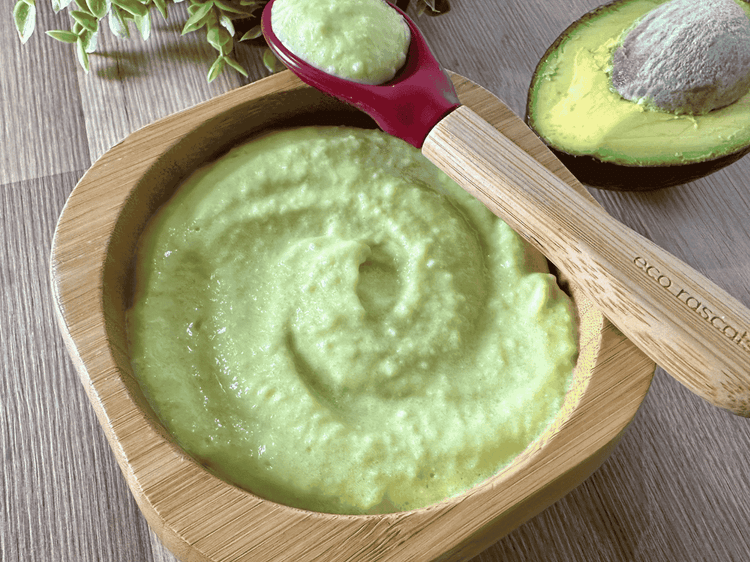
Avocado Rice Puree
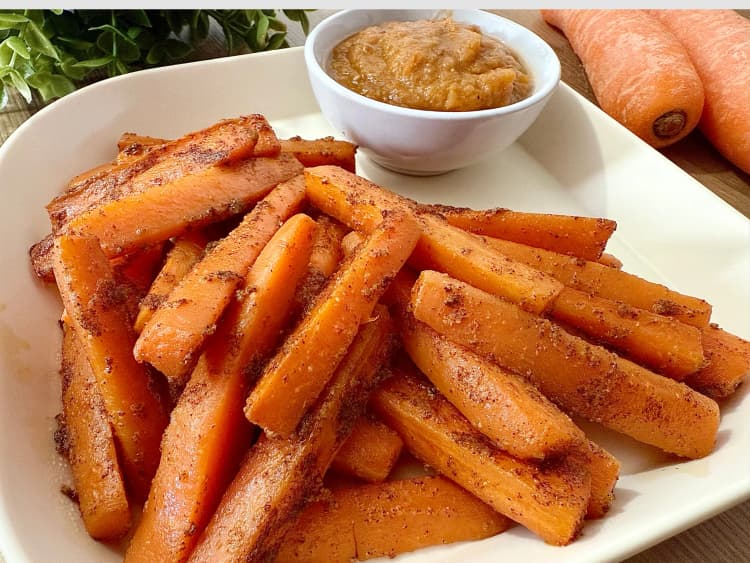
Carrot sticks
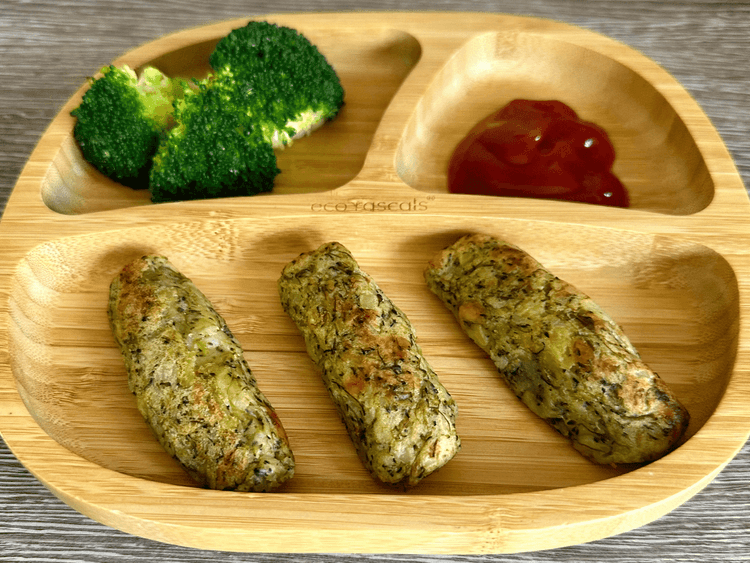
Potato Broccoli Tots

Easy Greek Yoghurt Banana Pancakes

Baked Cheesy Plantain Fritters

Easy Butternut Squash Muffins
Get new recipes to your inbox
Subscribe to our weekly newsletter and get new recipes sent to your inbox!